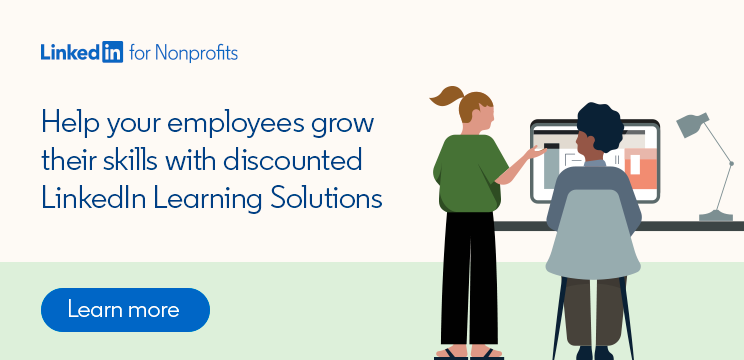
How This UK Nonprofit Uses LinkedIn Learning to Elevate Its Professional Development Efforts
As the UK’s leading dementia research nonprofit, Alzheimer’s Research UK is dedicated to making life-changing breakthroughs in the diagnosis, prevention, treatment, and cure of a condition that almost 600 people develop every day in the UK alone.
Achieving this mission is only possible if employees have the right skills, knowledge, and behaviors to deliver the organizational objectives. Alzheimer’s Research UK has a small learning and development team with big plans. They leverage LinkedIn Learning to help their nonprofit create a culture of continuous learning and support their workers’ professional development initiatives.
“LinkedIn Learning gives me the flexibility to develop content and learning pathways that support and enable our employees to develop their skills, knowledge, and experience across a wide range of topics,” says John Gregg, Head of Learning & Development at Alzheimer’s Research UK.
Since adopting LinkedIn Learning in 2020, Alzheimer’s Research UK has been able to provide wider opportunities for personal growth and has encouraged employees to feel more empowered to take ownership and responsibility for their own personal development and career aspirations. Here are John’s top three tips for other nonprofits hoping to do the same.
Tip 1: Start small and build employee interest
Working at a forward-thinking and supportive nonprofit, Alzheimer’s Research UK’s talented employees are determined to create a world free from the fear, harm, and heartbreak of dementia. With these ambitions, taking time out for learning can sometimes be challenging. Offering greater flexibility where all employees can learn at the point of need, and at a time that suits them, was a quick win to building levels of interest.
Fostering employee curiosity in LinkedIn Learning by using key calendar moments such as Mental Health Awareness Week enabled relevant content to be shared and helped generate further interest in a wider range of topics.
“Encourage as many people as you can to access learning content in the first three months and share their learnings in team meetings and on internal communication platforms such as Yammer or Slack communities,” John recommends. “You can then start thinking about what type of learning content you want to showcase. Think about what will have the most impact for individuals and teams — start small, then tier it up.”
Tip 2: Encourage leadership engagement
As Alzheimer’s Research UK began promoting the different types of learning content available to employees, John encouraged the Senior Leadership Team to be learning advocates. A new community called “Personal Growth” was created on their internal communications platform, Yammer, which was a great way to help build a culture of learning by sharing knowledge across the nonprofit on a variety of topics.
John asked each Director to recommend at least one piece of content that they had recently learned from or found inspiring per month. Alzheimer’s Research UK also empowered champions across the organization to share courses they had found interesting with other employees.
“The level of engagement with this initiative has been incredible because it’s been endorsed and driven at the most influential level — and as a result, encouraged other learners to also share content,” John says. “This has been so much more powerful than content being recommended by the organization.”
Tip 3: Align employee and organizational needs
Since adopting LinkedIn Learning, Alzheimer’s Research UK has continued to invest in other forms of professional development, including in-person training. John has found LinkedIn Learning especially useful for providing pre- and post-training support to employees, ensuring they can develop foundational skills and take refresher courses whenever they need to.
“We have to deliver content in certain ways to meet the organization’s requirements,” John explains. “But the great thing about LinkedIn Learning is that people can learn in the way that they want to — they can pick the format and the time that they want to learn.”
Today, Alzheimer’s Research UK creates collections of recommended LinkedIn Learning content to support every development program that it runs. On an individual level, the team can also quickly curate Learning Paths to address specific needs.
“I was having a conversation this week about somebody who wants to step up into a management role but hasn’t quite got the skills yet,” John says. “So we’re building them a Learning Path around what skills you need to be a good manager, like having difficult conversations and running team meetings.”
Having access to LinkedIn Learning also allows employees at Alzheimer’s Research UK to explore interests and growth opportunities beyond the scope of their current role, without putting a strain on the organization’s budget.
“If someone wants to do [an external] PRINCE2 course and they’re not a project manager, we can’t spend $4,000 per person on that course,” John says. “But can we share LinkedIn Learning content that gives them the skills to project manage? Absolutely.”
Like any nonprofit, Alzheimer’s Research UK is thoughtful about its budget. In John’s view, professional development is critical to achieving its mission, and the investment in LinkedIn Learning for nonprofits has proven its worth.
“It makes us better so that we can raise more money to put into our research to find a cure,” he says. “The only way we can do that is through supporting and enabling our people to develop the right skills, knowledge, and behaviors.”
If your organization is interested in finding out more about how LinkedIn Learning can support your team’s professional development, contact our team.

